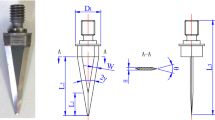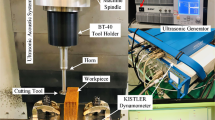Abstract
The applications of Nomex honeycomb composite (NHC) structures in aerospace, automotive and defence sectors have been significantly increasing due to their high compressive strength, hexagonal thin-walled structure, ultra-light weight and excellent thermal resistance. Specific applications include composite sandwich structures in helicopter propellers, satellite cabins, aeroplane floors, engine cowls, wings and nacelles. Accuracy of the machined surface of NHC structures is required for adhesive bonding with face-sheets. Conventional machining processes generate machining defects in terms of tearing, damaged cell walls, burr formation, delamination and poor surface quality that result in reduction of strengths of the core structure and its bond with face sheet. Ultrasonic machining is a proven technique to overcome such machining defects and improve the surface quality of NHC structures. Novelty of this research includes the development of a three-dimensional (3D) finite element model to analyse cutting forces, chip formation and machining quality of NHC structures using disc cutter through both ultrasonic and conventional machining processes by providing feed to the workpiece instead of the cutting tool. The significant influence of machining parameters such as depth of cut, feed rate, ultrasonic amplitude and spindle speed on cutting forces was investigated numerically followed by experimental validation. Numerical model in support with experimental results show that cutting forces decrease by increasing ultrasonic amplitude and spindle speed (up to 54.74% and 62.71%, respectively), and increase with the increase of depth of cut and feed rate (up to 60% and 60.48%, respectively). It was also found that the ultrasonic machining reduces the magnitude of cutting forces as compared to conventional machining (up to 42.74%). Surface morphology analysis through scanning electron microscope also indicated improved machining quality achieved by ultrasonic machining at NHC structures’ hexagonal cells, triple points and walls. A burr formation of 5% was observed during ultrasonic machining of NHC structures for \({F}_{y}\le 3 \mathrm{N}\), while it was found up to 10% if \({F}_{y}>3 \mathrm{N}\), compared to at least 30% burr during conventional machining. To sum up, the employed methodology can be effectively applied for determining the effect of various machining parameters on cutting forces as well as surface quality, chip formation, structural integrity and dimensional accuracy of machined NHC structures during ultrasonic machining process.

























Similar content being viewed by others
Data availability
All the data generated or analysed during this research are included in this manuscript.
References
Liu Y, Liu W, Gao W (2021) Out-of-plane shear property analysis of Nomex honeycomb sandwich structure. J Reinf Plast Compos 40(34):165–75. https://doi.org/10.1177/0731684420943285
Roy R, Nguyen KH, Park YB, Kweon JH, Choi JH (2014) Testing and modeling of NomexTM honeycomb sandwich panels with bolt insert. Compos Part B Eng 56:762–769. https://doi.org/10.1016/j.compositesb.2013.09.006
Heimbs S, Middendorf P, Hampf C, Hähnel F, Wolf K (2008) Aircraft sandwich structures with folded core under impact load. In Proc. of the 8th International Conference on Sandwich Structures. ICSS8, Porto, Portugal, pp 369–380
Xie S, Wang H, Yang C, Zhou H, Feng Z (2020) Mechanical properties of combined structures of stacked multilayer Nomex® honeycombs. Thin-Walled Structures 1(151):106729. https://doi.org/10.1016/j.tws.2020.106729
Zenkert D (1997) The handbook of sandwich construction. Engineering Materials Advisory Services
Sun J, Dong Z, Wang X, Wang Y, Qin Y, Kang R (2020) Simulation and experimental study of ultrasonic cutting for aluminum honeycomb by disc cutter. Ultrasonics 103:106102. https://doi.org/10.1016/j.ultras.2020.106102
Yu H, Hu X, Kong L, Yu B (2019) Process path planning based on efficiency model for ultrasonic cutting curved surface of honeycomb composite parts. Adv Mech Eng 11(10):1687814019884176
Ke M, Jianfu Z, Pingfa F, Zhijun W, Dingwen Y, Ahmad S. (2019) Design and implementation of a mini ultrasonic cutting system for nomex honeycomb composites. In 2019 16th International Bhurban Conference on Applied Sciences and Technology (IBCAST), IEEE, pp 148–152. https://doi.org/10.1109/IBCAST.2019.8667261.
Jaafar M, Atlati S, Makich H, Nouari M, Moufki A, Julliere B (2017) A 3D FE modeling of machining process of Nomex® honeycomb core: influence of the cell structure behaviour and specific tool geometry. Procedia Cirp 58:505–510. https://doi.org/10.1016/j.procir.2017.03.255
Rodríguez JM, Carbonell JM, Jonsen P (2020) Numerical methods for the modelling of chip formation. Arch Comput Methods Eng 27(2):387–412. https://doi.org/10.1007/s11831-018-09313-9
Jaafar M, Nouari M, Makich H, Moufki A (2021) 3D numerical modeling and experimental validation of machining Nomex® honeycomb materials. Int J Adv Manuf Technol 115(9):2853–2872
Jiang J, Liu Z (2021) Formation mechanism of tearing defects in machining Nomex honeycomb core. Int J Adv Manuf Technol 112(11):3167–3176. https://doi.org/10.1007/s00170-021-06603-8
Zarrouk T, Salhi JE, Atlati S, Nouari M, Salhi M, Salhi N (2021) Study on the behavior law when milling the material of the Nomex honeycomb core. Mater Today: Proc 1(45):7477–7485. https://doi.org/10.1016/j.matpr.2021.02.110
Mughal KH, Qureshi MA, Qaiser AA, Ahmad F Numerical Evaluation of State of the Art Horn Designs for Ultrasonic Vibration Assisted Machining of Nomex Honeycomb Composite. Technology 5:7. https://doi.org/10.21203/rs.3.rs-207300/v1
Zarrouk T, Salhi JE, Atlati S, Nouari M, Salhi M, Salhi N (2022) Modeling and numerical simulation of the chip formation process when machining Nomex. Environ Sci Pollut Res 29(1):98–105. https://doi.org/10.1007/s11356-021-13736-6
Hu XP, Yu BH, Li XY, Chen NC (2017) Research on cutting force model of triangular blade for ultrasonic assisted cutting honeycomb composites. Procedia CIRP 1(66):159–163. https://doi.org/10.1016/j.procir.2017.03.283
Xiang D, Wu B, Yao Y, Liu Z, Feng H (2019) Ultrasonic longitudinal-torsional vibration-assisted cutting of Nomex® honeycomb-core composites. Int J Adv Manuf Technol 100(5):1521–1530
Xiang DH, Wu BF, Yao YL, Zhao B, Tang JY (2019) Ultrasonic vibration assisted cutting of nomex honeycomb core materials. Int J Precis Eng Manuf 20(1):27–36. https://doi.org/10.1007/s12541-019-00038-8
Ahmad S, Zhang J, Feng P, Yu D, Wu Z (2020) Experimental study on rotary ultrasonic machining (RUM) characteristics of Nomex honeycomb composites (NHCs) by circular knife cutting tools. J Manuf Process 1(58):524–535
Cui R, Zhang J, Feng P, Yu D, Wu Z (2020) A path planning method for v-shaped robotic cutting of Nomex honeycomb by straight blade tool. IEEE Access 2(8):162763–162774. https://doi.org/10.1109/ACCESS.2020.3021121
Cao W, Zha J, Chen Y (2020) Cutting force prediction and experiment verification of paper honeycomb materials by ultrasonic vibration-assisted machining. Appl Sci 10(13):4676. https://doi.org/10.3390/app10134676
Ahmad S, Zhang J, Feng P, Yu D, Wu Z, Ke M (2020) Processing technologies for Nomex honeycomb composites (NHCs): a critical review. Compos Struct 250:112545. https://doi.org/10.1016/j.compstruct.2020.112545
Kang D, Zou P, Wu H, Duan J, Wang W (2019) Study on ultrasonic vibration–assisted cutting of Nomex honeycomb cores. Int J Adv Manuf Technol 104(1):979–992. https://doi.org/10.1007/s00170-019-03883-z
Xu Q, Bao Y, Wang YQ, Gao H (2021) Investigation on damage reduction method by varying cutting angles in the cutting process of rectangular Nomex honeycomb core. J Manuf Process 68:1803–1813
Mughal KH, Qureshi MAM, Raza SF (2021) Novel ultrasonic horn design for machining advanced brittle composites: a step forward towards green and sustainable manufacturing. Environ Technol Innov 23:101652
Mughal KH, Qureshi MAM, Qaiser AA, Khalid FA, Maqbool A, Raza SF, Ahmad S, Zhang J (2022) Numerical investigation of the effect of uniform cutout on performance of ultrasonic horn for machining Nomex honeycomb core material. Jurnal Kejuruteraan 34(3):523–533. https://doi.org/10.17576/jkukm-2022-34(3)-19
Mughal KH, Qureshi MA, Qaiser AA, Khalid FA, Maqbool A, Raza SF, Ahmad S, Zhang J (2022) Tubular Bezier Horn Optimum Design for Ultrasonic Vibration Assisted Machining of Nomex Composite. In 2022 19th International Bhurban Conference on Applied Sciences and Technology (IBCAST), IEEE, pp 26–32. https://doi.org/10.1109/IBCAST54850.2022.9990497
Mughal KH, Qureshi MAM, Qaiser AA, Khalid FA, Maqbool A, Raza SF, Ahmad S, Zhang J (2022) Dynamic performance evaluation of ultrasonic composite horn for machining soft and brittle composites. Jurnal Kejuruteraan 35(1):169–178. https://doi.org/10.17576/jkukm-2023-35(1)-16
Munir MM, Mughal KH, Qureshi MA, Qaiser AA, Khalid FA (2023) Design of Novel Longitudinally–Torsionally Coupled Ultrasonic Bezier Horns for Machining Advanced Hard and Brittle Materials. J Vib Eng Technol. 1–8. https://doi.org/10.1007/s42417-023-01158-2
Mughal KH, Qureshi MAM, Khalid FA, Qaiser AA, Ahmad S, Maqbool A, Raza SF, Zhang J (2024) Harmonic excitation response of standard ultrasonic horn designs for machining Nomex honeycomb core composite. Jurnal Kejuruteraan 36(1): In Press
Karakoç A, Freund J (2012) Experimental studies on mechanical properties of cellular structures using Nomex® honeycomb cores. Compos Struct 94(6):2017–2024. https://doi.org/10.1016/j.compstruct.2012.01.024
Fan XL, Wang TJ, Sun Q (2011) Damage evolution of sandwich composite structure using a progressive failure analysis methodology. Procedia Eng 1(10):530–535. https://doi.org/10.1016/j.proeng.2011.04.089
Funding
This research work is supported by the Pakistan Science Foundation (Project No. PSF/NSFC-II/Eng/P-UET (01)), National Natural Science Foundation of China (NSFC) (Grant No. 51761145103 and Grant No. 51875311) and Shenzhen Foundational Research Project (Grant No. JCYJ20160428181916222).
Author information
Authors and Affiliations
Contributions
KHM: conceptualisation, methodology, writing—original draft, writing—review and editing, data curation, collecting documents. MFJ: writing—original draft, methodology. MAMQ: data curation, collecting documents, writing—review and editing, supervision. AAQ: collecting documents, supervision. FAK: conceptualisation, supervision. AM: collecting documents, conceptualisation. SFR: methodology. SA: methodology. JZ: conceptualisation, supervision. SZA: methodology.
Corresponding authors
Ethics declarations
Consent to participate
All authors agree to participate.
Consent for publication
All authors agree to publication.
Conflict of interest
The authors declare no competing interests.
Additional information
Publisher's Note
Springer Nature remains neutral with regard to jurisdictional claims in published maps and institutional affiliations.
Rights and permissions
Springer Nature or its licensor (e.g. a society or other partner) holds exclusive rights to this article under a publishing agreement with the author(s) or other rightsholder(s); author self-archiving of the accepted manuscript version of this article is solely governed by the terms of such publishing agreement and applicable law.
About this article
Cite this article
Mughal, K.H., Jamil, M.F., Qureshi, M.A.M. et al. Investigation of rotary ultrasonic vibration assisted machining of Nomex honeycomb composite structures. Int J Adv Manuf Technol 129, 5541–5560 (2023). https://doi.org/10.1007/s00170-023-12652-y
Received:
Accepted:
Published:
Issue Date:
DOI: https://doi.org/10.1007/s00170-023-12652-y




